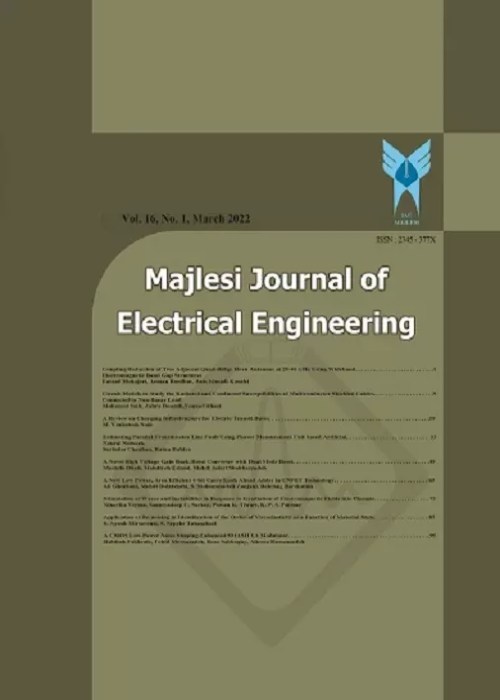فهرست مطالب

Majlesi Journal of Electrical Engineering
Volume:9 Issue: 2, Jun 2015
- تاریخ انتشار: 1394/05/12
- تعداد عناوین: 7
-
Pages 1-9Modern electric power utilities are facing many challenges due to increasing complexity in their operation and structure. In the recent times, one of the problems that got wide attention is the power system instabilities due to lack of new transmission facilities. Existing transmission facilities can be better utilized by installing Flexible AC Transmission System (FACTS) devices. The TCSC is the most effective FACTS device used to increase the power transferable capabilities of the transmission line. This paper presents a Sensitivity analysis based Complex Power Flow Sensitivity Index (CPSI) calculated for placing the TCSC at an appropriate location. Once the location to install the TCSC is determined, the optimal tuning of the TCSC and the impact of TCSC on Generation reallocation is determined through Firefly Algorithm. This Algorithm is implemented on multi objective function to obtain the Optimal Power Flow. The multi objective function consists of total real power loss, total voltage magnitude deviations, the fuel cost of total real power generation and the branch loading. Simulations have been carried out in MATLAB environment for the IEEE 57-bus system. The results have been taken for Firefly Algorithm based Optimal Power Flow without and with TCSC. The results obtained with Firefly Algorithm were compared with Genetic Algorithm (GA).
-
Pages 11-26In this paper, we investigate on Indirect Model Reference Adaptive Neuro Control (IMRANC), for output electrical power tracking of a nonlinear non-affine Horizontal Axis Wind Turbine (HAWT). The nonlinear system is first identified by the Nonlinear Autoregressive network with Exogenous inputs (NARX) model that is a recurrent dynamic network. Afterward an IMRANC is designed based on NARX identified model to reach the close loop system to desired reference model. The MLP networks are applied for both of model and controller subsystems and are then trained by the Marquardt-Levenberg Back-Propagation (LMBP) algorithm while the Tapped Delay Lines (TDL) components are considered over input and feedback paths. Simulation results are final presented to validate the effectiveness of the proposed method like robustness and good load disturbance attenuation and accurate tracking, even in the presence of parameter variations due to changing of hydraulic pressure in hydraulic pitch system and also disturbances on the system.
-
Pages 27-35In this paper, error dynamic model of Strapdown inertial navigation system (SINS) is employed for error compensation of Strapdown algorithm. Perfect visual sensor data is fused with inertial sensors to produce deviation vectors as noisy measurement models. Due to the high dimensional and sparse error dynamic, the system is decomposed to cascaded subsystems because of the system structure. Then, distributed (cascaded) Kalman filters (KFs) and state feedback compensators are designed according to interactions of subsystems. This not only speeds up computations and avoids error propagation but also makes tuning, debugging, and the verifying of the algorithm from the perspective of implementation easier and more precise. The proposed architecture is appropriate to be implemented by multiple processors. The experimental results based on data from 3D MEMS IMU and camera system are provided to demonstrate efficiency of the proposed method.
-
Pages 37-42This article aims to investigate synchronization of UWB signals between transmitter and receiver in communication networks. In Ultra wideband technology, synchronization consists of two sections. In the former section coarse synchronization has been accomplished which leads to fine one at the end. In first section of coarse synchronization, maximum detection was utilized. In order to improve the performance of the synchronization algorithm and decreasing the complexity of calculation, in second section of coarse synchronization search back algorithm was presented. Synchronizations were performed in MATLAB and the results were the indication of a decrease in calculation and improvement in synchronization performance. To evaluate the performance of synchronization algorithms MAE, RMSE were utilized as two criteria and the results obtained explains the fact that RMSE criterion in search back algorithm has better performance for lower SNR.
-
Pages 43-50Priority Queue (PQ) algorithm is used as the scheduling scheme for Resilient Packet Ring network (RPR). The scheduler handles a specific queue on the basis that all the higher priority queues have been served and emptied. This approach ensures low delay for higher priority classes of traffic. However, it often leads to the starvation of lower priority queues. For both single transit and double transit buffer architecture, traffic on the ring, which is a mixture of HP and LP transit traffic, has higher priority over the transmit HP traffic. This could cause the LP traffic on the ring to block the transmit HP traffic from gaining access onto the ring. To improve the quality of service for high priority traffic transmission, we propose using Bitwise Round-Robin (BRR) algorithm to alternately select packets from the transit buffer and the high priority transmit buffer. Simulation results show certain improvement on overall delay and delay jitter performance of RPR networks by using our scheme.
-
Pages 51-58This paper proposes a backstepping terminal sliding mode control with adaptive algorithm which applied to Quadrotor for free chattering, finite time convergence and robust aims. First of all, dynamic equation of a quadrotor has been obtained based on Euler-Lagrangian equations with considering additional disturbance and uncertainty. Furthermore, a nonlinear control scheme has been proposed to deal against defined perturbations. In the proposed control scheme, instead of using regular control input, the derivative of the control input has been achieved from terminal second-layer sliding surface. An adaptive algorithm has been used to achieve the robust performance against external disturbances like wind effects. The adaptive control law estimates the upper bound of disturbance and uncertainty. Stability and robustness of the proposed controller have been proved by using the classical Lyapunov criterion. The simulation results demonstrate the validation of the proposed control scheme.Keywords: Adaptive algorithm, Backstepping method, Terminal second order sliding mode, Quadrotor
-
Pages 59-66Spectrum sensing is a key function of Cognitive Radio (CR) networks. An accurate spectrum sensing scheme can improve spectrum utilization. But, in practice, detection performance is often degraded with multipath fading, shadowing and receiver uncertainty issues. To overcome the impact of these issues, Collaborative Spectrum Sensing (CSS) has been shown to be an effective approach to improve the detection performance by exploiting diversity. The reliability of CSS can be severely degraded by Spectrum Sensing Data Falsification (SSDF) attacks. Protecting the CR networks against SSDF attacks, Weighted Sequential Probability Ratio Test (WSPRT) has been proposed. Compared with conventional SPRT, the WSPRT improves correct sensing probability at the cost of increasing sampling overhead. In the present study, weighted majority rule is introduced and combined with the WSPRT to improve trustworthiness of collaborative spectrum sensing in the presence of SSDF attackers. Furthermore, to avoid increasing the sampling overhead, Roulette Wheel Selection (RWS) algorithm is used to collaborative node selection. The proposed method is called Developed WSPRT (DWSPRT). Simulation results show that the DWSPRT is an effective data fusion approach against SSDF attacks, especially for CR networks located in hostile environments.


